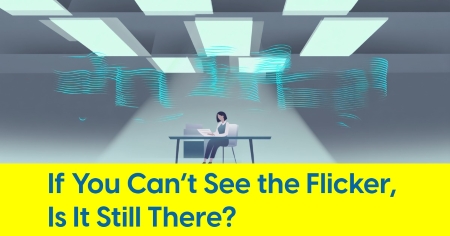September 6, 2023
Are Light Flashes the Answer to Jet Lag?

New research findings support light therapy for travel and shift work fatigue
A just published novel study sheds light on a possible solution for those grappling with the effects of jet lag or erratic work hours. It seems that quick flashes of light during sleep might hold the key to resynchronizing our body's internal clock.
If you’re a lighting person, you likely already know that humans operate on an innate timing system known as the circadian rhythm. This internal "clock" governs our sleep-wake cycle, among other physiological processes. Disruptions to this cycle, such as those experienced by frequent travelers or shift workers, can lead to a host of issues, including sleep disturbances and fatigue. The quest to address these disruptions led to the investigation of "flash therapy."
Researchers Renske Lok, Marisol Duran, and Jamie M. Zeitzer sought to unravel the potential benefits of flash therapy. Their findings, published in Scientific Reports, offer insights into how sequences of light flashes during sleep might help recalibrate our circadian rhythm.
Key Findings:
-
Flash Therapy Effects: The study revealed that after being exposed to 2-ms light flashes every 15 seconds for an hour, there was a significant delay in participants' dim light melatonin onset (DLMO), by an average of 1.13 hours. Interestingly, in certain instances, this delay spanned as much as 6.4 hours.
-
Impact on Sleep: Using polysomnography, a technique to record sleep patterns, the study confirmed that sleep quality remained mostly unaffected by flash therapy. Though there were minor indications of increased sleep instability post-therapy, the core architecture of sleep was largely preserved.
-
Mechanism of Flash Therapy: On the cellular level, the mechanics of flash therapy might be tied to the unique behavior of intrinsically photosensitive retinal ganglion cells (ipRGCs) after exposure to light. It's believed that the continued response of these cells to light may be the foundation on which flash therapy operates.
Practical Implications:
For those familiar with the woes of jet lag or the fatigue of irregular work schedules, flash therapy emerges as a beacon of hope. By potentially delaying the internal clock during rest, flash therapy offers an avenue to mitigate the unpleasant side effects of these disruptions without resorting to long durations of light exposure at potentially awkward hours.
While the initial findings are noteworthy, it's important to highlight that the research was conducted in controlled environments.. This included maintaining a stable circadian rhythm for participants and ensuring they were exposed to specific light conditions. How flash therapy translates to more diverse settings remains to be seen. Delving deeper into how individuals might react differently to the therapy and ensuring its broader applicability will be central to subsequent studies.
The initial findings of this study may pave the way for more extensive research that explores the role of flash therapy in combating circadian disruptions. In the interim, the study stands as a noteworthy progress towards better understanding the various ways in which light can be harnessed for our well-being.
The study was funded by a grant from the U.S. Department of Defense. The authors associated with the study are Renske Lok and Jamie M. Zeitzer, both affiliated with the Department of Psychiatry and Behavioral Sciences at Stanford University, Stanford, CA. Additionally, Marisol Duran is affiliated with the Palo Alto Veterans Institute for Research in Palo Alto, CA. Jamie M. Zeitzer also holds an affiliation with the Mental Illness Research Education and Clinical Center at the VA Palo Alto Health Care System in Palo Alto, CA.










